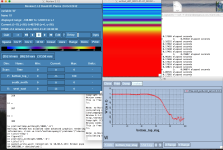Hello WRF friends,
I'm trying to simulate gravity waves, caused by convection, going up through the stratosphere, with WRF version 3.9.1.1.
My starting point is the standard em_quarter_ss supercell test case, with some changes: bigger domain, more points, more vertical levels.
And, I move the model top up to 50 km.
If I use the standard "stretch_grid=true" with zs = 0.4, ideal.exe fails to put the model top as high as I want it. It also fails to keep equal vertical grid spacing, as DZ between the top few levels increases drastically, so that the vertical grid spacing near the top becomes 1-2 km.
If figured out that decreasing zs (e.g., zs = 0.2) brings the model levels closer and closer to evenly spaced in the upper levels of the domain, and also allows ideal.exe to get closer to the target model top. Near the top, the numerical spacing in the ZNW levels becomes very small.
However, in this case, the model blows up instantly. A downward moving wave of W with values of 50-100 m/s appears in the first few time steps. Decreasing the time step to very small values does not make a difference, nor does different damping options.
So my questions are:
1) Is there something about making the vertical grid spacing in ZNW very very small that causes the model to fail?
2) Or in general is WRF unable to use vertically even grid spacings at very high altitudes?
Thanks for your time.
Dave Nolan
I'm trying to simulate gravity waves, caused by convection, going up through the stratosphere, with WRF version 3.9.1.1.
My starting point is the standard em_quarter_ss supercell test case, with some changes: bigger domain, more points, more vertical levels.
And, I move the model top up to 50 km.
If I use the standard "stretch_grid=true" with zs = 0.4, ideal.exe fails to put the model top as high as I want it. It also fails to keep equal vertical grid spacing, as DZ between the top few levels increases drastically, so that the vertical grid spacing near the top becomes 1-2 km.
If figured out that decreasing zs (e.g., zs = 0.2) brings the model levels closer and closer to evenly spaced in the upper levels of the domain, and also allows ideal.exe to get closer to the target model top. Near the top, the numerical spacing in the ZNW levels becomes very small.
However, in this case, the model blows up instantly. A downward moving wave of W with values of 50-100 m/s appears in the first few time steps. Decreasing the time step to very small values does not make a difference, nor does different damping options.
So my questions are:
1) Is there something about making the vertical grid spacing in ZNW very very small that causes the model to fail?
2) Or in general is WRF unable to use vertically even grid spacings at very high altitudes?
Thanks for your time.
Dave Nolan

